

Et si l’autocompassion était la marque distinctive des grands dirigeants. Leadership Le 28/02/2017 La compassion n’est pas un sentiment que l’on s’attendrait à trouver dans le monde parfois sans pitié de l’entreprise.

Et pourtant, elle pourrait être la première vertu du dirigeant. Les dirigeants qui font preuve de compassion envers leurs employés favorisent la résilience individuelle et collective dans les périodes de changement, selon le CompassionLab de l’université du Michigan. Et le développement de la dimension compassion-empathie du leader a un impact positif sur la perception de justice interpersonnelle et la reconnaissance chez ses salariés, selon une recherche de l’Institut français du leadership positif.
Dossier – Gestion des émotions. La qualité de vie d’une personne est directement reliée à sa santé émotionnelle.

Quelle est l'émotion qui dure 240 fois plus longtemps que les autres. Une émotion qui nécessite en moyenne 4 jours pour s’estomper L’émotion qui a la plus longue durée de vie est la tristesse, dit l’une des première étude à se pencher sur les raison de la durée si variable des émotions.
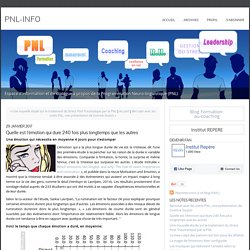
Comparée à l’irritation, la honte, la surprise et même l’ennui, c'est la tristesse qui surpasse les autres. L'étude intitulée « Which emotions last longest and why: The role of event importance and rumination », et publiée dans la revue Motivation and Emotion, a montré que la tristesse tendait à être associée à des événements qui avaient un impact majeur à long terme sur la vie des gens, comme le deuil (Verduyn et Lavrijsen, 2014). Daniel Goleman Master Class: motivation power, affiliation, and realization.
Emotional Intelligence 2.0 - Take the Test. Privacy Policy TalentSmart is serious about respecting your privacy.
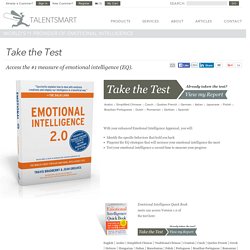
Our goal is outstanding service, which includes strict adherence to the following Privacy Policy. Empathie. Empathie. The Emotional Impulses That Poison Healthy Teams. Courtesy of Harvard Business Review Is anyone really an individual contributor at work anymore?
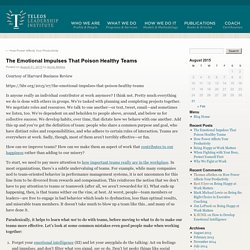
I think not. Pretty much everything we do is done with others in groups. We’re tasked with planning and completing projects together. We negotiate roles and resources. How can we improve teams? To start, we need to pay more attention to how important teams really are in the workplace. Paradoxically, it helps to learn what not to do with teams, before moving to what to do to make our teams more effective. Forget your emotional intelligence (EI) and let your amygdala do the talking: Act on feelings and impulses, and don’t filter what you signal, say or do. Far too many of us work in groups that are more than dysfunctional—they are painful and they make us very unhappy. Working effectively in teams takes effort—and it takes emotional intelligence. Emotional Empathy and Cognitive Empathy.
Chris Allen Thomas Empathy is the ability of people to recognize and respond to the emotions of others.

It’s the foundation of both sympathy and compassion. Withoutempathy, sympathy and compassion are more likely to be inaccurate and may lead to increased friction and resentment. This is because the individuals who are the targets of sympathy or compassion have heightened sensitivity to actions that are not based on empathetic understanding. They may feel that actions such as an act of charity or a compassionate word are degrading forms of pity if they are not based on an attempt at understanding the recipient’s reality.
In leadership literature, empathy is an ability to recognize a broad spectrum of emotional signals, allowing leaders to feel the unspoken emotions of other individuals or groups. Empathy provides a foundation for guiding our behaviors toward others. Cognitive empathy is deliberate, a skill that everyone at work can learn and needs to use. . [4] Staub, E. The Emotional Impulses That Poison Healthy Teams. The Power of Empathy. The erosion of empathy: Simon Baron Cohen at TEDxHousesofParliament. Three Kinds of Empathy: Cognitive, Emotional, Compassionate. Being cool in crisis seems essential for our being able to think clearly.
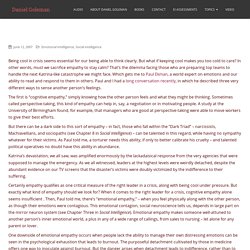
But what if keeping cool makes you too cold to care? In other words, must we sacrifice empathy to stay calm? That’s the dilemma facing those who are preparing top teams to handle the next Katrina-like catastrophe we might face. Which gets me to Paul Ekman, a world expert on emotions and our ability to read and respond to them in others. Paul and I had a long conversation recently, in which he described three very different ways to sense another person’s feelings.
The first is “cognitive empathy,” simply knowing how the other person feels and what they might be thinking. But there can be a dark side to this sort of empathy – in fact, those who fall within the “Dark Triad” – narcissists, Machiavellians, and sociopaths (see Chapter 8 in Social Intelligence) – can be talented in this regard, while having no sympathy whatever for their victims. What is Empathy? Empathy is, at its simplest, awareness of the feelings and emotions of other people.

It is a key element of Emotional Intelligence, the link between self and others, because it is how we as individuals understand what others are experiencing as if we were feeling it ourselves. Different Kinds of Empathy. Why Some Teams Are Smarter Than Others. Individual intelligence, as psychologists measure it, is defined by its generality: People with good vocabularies, for instance, also tend to have good math skills, even though we often think of those abilities as distinct.
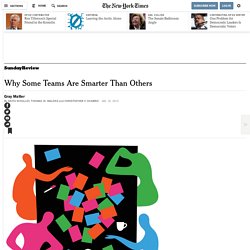
The results of our studies showed that this same kind of general intelligence also exists for teams. On average, the groups that did well on one task did well on the others, too. In other words, some teams were simply smarter than others. We next tried to define what characteristics distinguished the smarter teams from the rest, and we were a bit surprised by the answers we got. We gave each volunteer an individual I.Q. test, but teams with higher average I.Q.s didn’t score much higher on our collective intelligence tasks than did teams with lower average I.Q.s. Instead, the smartest teams were distinguished by three characteristics. First, their members contributed more equally to the team’s discussions, rather than letting one or two people dominate the group.